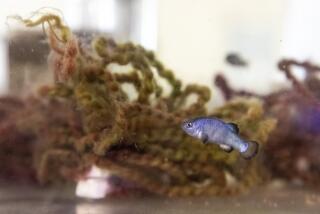Talking Squawfish : Collection of Storytellers Reveals Colorful Past of Monster Species That Thrived in the Old West
Nothing against Cary Barber, but there are probably better ways to impress a young woman than to present her with a dull-green fish shaped like a torpedo and with a gaping mouth that looks as though it has lips.
But then Barber’s courting days were decades ago in rural Colorado, where such a gift might not have been offensive. And it was the biggest fish he had ever caught or even seen.
“It was spring, and . . . I was just 17 and there was a young lady living at the Barnes’ place,” said Barber, of Maybell, Colo. “I figured me catching the fish would maybe make a good impression on an attractive young lady.”
Barber was a cowboy then, and after clubbing the fish on the head with a tree branch, he hung it from the pommel of his saddle and galloped off to the Barnes’.
“Mrs. Barnes had just hung her washing on the clothesline,” Barber said. “She saw the monster fish and went in to get a camera. About then, I felt the horse flinch a bit and I looked down in time to see that darn fish come to life and give a mighty slap with its tail, catching my horse in the belly. I tried to get off with dignity, but my horse helped me off in a hurry, then ran off. The strap holding the fish broke, and the horse took off right through the clothesline, which caught on the saddle horn and strung out for a quarter of a mile along the Greasewood Flats.”
It is not known whether Barber’s courting was successful. His story, pulled from the clips of an old issue of Colorado Outdoors magazine, is only one of many compiled recently by Fred Quartarone of the Colorado Division of Wildlife in a joint effort with the U.S. Fish and Wildlife Service.
Quartarone’s assignment was to gather first-hand information regarding four species of fish native to the upper Colorado basin that once thrived before falling victim to progress and landing on the endangered species list in the 1970s.
Quartarone interviewed more than 100 people with an average age of 77. They recalled encounters with razorback suckers, humpback chubs, bonytail chubs and a member of the minnow family called the Colorado squawfish, which grew to 6 feet and gobbled up practically anything cast its way.
The purpose of the report, for the Information and Education Committee of the Recovery Program for the Endangered Fish of the Upper Colorado River Basin, was to learn how people interacted with the fish, both as a means of recreation and of sustenance. If nothing else, the report provides a colorful look at the way things were before pollution, dams and the introduction of hatchery-raised trout and catfish forever changed the fisheries of the upper Colorado River basin.
Accounts of squawfish, which used to migrate up and down the rivers in such numbers that early settlers referred to them as “white salmon,” dominate the report.
Said Gene Bittler, of Maybell, Colo.: “I pitched a green frog out there and this whitefish (as squawfish were commonly called) hit it just about straight across, and he ran down the fast water, riffles, and took out about 200 feet of line before I turned him around. It was one of the most thrilling fish I ever caught if you want to know the truth. . . . “
To such old-time anglers, there was no such thing as Power Bait. But the squawfish wasn’t finicky, so there was no need for such glop.
“My grandfather would get chicken parts, just great big old chunks of chicken parts and stuff like that, put a hook in it and throw it out into the river into those big holes down there with clothesline,” said Tim Merchant, of Green River, Wyo. “He just tied the clothesline onto the bumper of the truck. And when that went tight they’d just back the truck up and drag those fish out on the bank.”
Barber’s monster squawfish was the second to take him to the cleaners on that eventful day at the Barnes’ spread. The first, he said, was 4 feet and was caught on a baby blackbird he scooped up from the river bank.
Barber said the fish gave him rope burns when he used a hand-line to pull it to shore. His older companions were impressed by the size of the fish, though, and told him to catch another. Barber had no bait, but that wasn’t going to stop a resourceful young cowboy.
“I hunted a nest of mice, baited up and went fishing,” Barber said. “But, remembering the rope burns from the fish line, I decided to fish on horseback with a dally around the saddle horn. Right off, a whopper latched onto the mice and was hooked. I didn’t fool around, but doubled the dally on the saddle horn and hauled that fish off like I was dragging a calf to the branding fire.”
Mice were said to be favored over other bait for catching squawfish. Swallows were a close second. The birds would build their nests on canyon walls, and when--or before--it was time to fly, they would often plop into the river.
“This one time when we were fishing, the baby swallows were just leaving their nests,” said Chuck Mack of Craig, Colo. “A lot of them fell into the river and drowned. Every big squawfish in the Green River must have migrated to the canyon to feast on the swallows because we sure caught a lot of them. Or, let’s say, we sure had a lot of them hooked. The tackle we were using was a little light for 50-pound fish. Every one we gutted out had a stomach plumb full of baby swallows.”
Tom Hastings of Green River, Utah, said he used to spear squawfish simply for the fun of it. “My brother and I, we waded in there, the water hit me about (chest-high),” Hastings said. “One of them (Colorado squawfish) damn near drowned me. I hooked into him, he took me down out of there . . . I was small and wasn’t about to turn him loose. I was about 7 or 8. My brother, he was older; he got down there and got me, and I still had my fish.”
Colorado squawfish were apparently so highly prized that fishermen often hauled in 60- to 80-pounders--using whole cottontail rabbits for bait. The flesh of the squawfish was full of bones, but as one Depression-era fishermen noted: “We were so cotton-picking poor that we didn’t know good from bad.”
Those were the days of community fish fries. Farmers in Loma, Colo., held one every fall, until politics got in the way.
“Farmers went to the river on a Saturday and with either four or six boats they hung nets between each pair of boats, catching hundreds of large fish,” read an old account in the Journal of the Western Slope. “They kept the fish alive in vats of water overnight, then early Sunday they were dressed by the members of the women of the Loma Community Club, and the men fried them. It was hard work, but we had a day of fun until the office seekers from all over the state started to swarm over the place. Republicans swore, Democrats cussed, and the Loma community decided it was not worthwhile. No more fish fries!”
Not long after the Depression, dams began to spring up in various rivers of the region, essentially dooming the Colorado squawfish and other native fish, which preferred the fast-flowing water of untamed rivers.
But it was the growing appeal of hatchery-raised trout and catfish that led to the downfall of squawfish, chubs and suckers. Trout were more colorful, not so full of bones and flavorful. Catfish were meaty and somewhat of a challenge on hook and line.
Communities began to realize that they could achieve greater economic benefits by stocking the more popular gamefish, attracting the fishermen from other regions.
Catfish had a direct impact on squawfish.
“The reason the (squawfish) disappeared was because they introduced the channel cat,” recalled Wanda Staley of Vernal, Utah. “The whitefish or, as you call them, squawfish would swallow the channel cat and those barbs (on the catfish’s back) would get stuck in their throat and it would kill them. We found a number of them that died that way.”
The squawfish had no such trouble with the trout, gobbling them up so fast that newly converted trout fishermen began to pressure government officials into taking some sort of action. Some didn’t wait.
“See, we (would) take them (squawfish), seine them out of the river and dump them on the lawn, let them die on the banks, (and) we’d get a gunny sack full and use them for fertilizer, or whatever,” recalled Don Hatch of Vernal, Utah. “If you couldn’t eat them, what good were they, anyway? Of course, we didn’t think they were pretty, either, like rainbow trout.”
Finally, fisheries officials embarked on several rotenone poisoning projects, beginning in the early 1960s, to control the growth of the Colorado squawfish. The programs were limited in nature, but in one instance, the rotenone spread farther than anticipated, and the ensuing fish kill was said to have left the banks littered with native fish.
The recovery to date has been slow. The bonytail chub is close to extinction; the humpback chub has a fairly stable population in the Little Colorado River; the razorback sucker has small populations in various upper Colorado tributaries.
As for the Colorado squawfish, it exists primarily in parts of the Colorado River and nearby Green and Yampa rivers, but few fish exceed 30 inches, a far cry from the monsters that were part of the lives of young cowboys in love and settlers looking to put food on the table.
“They was as big as a junior high school kid, that’s a big fish,” Merchant said. “They were bigger than me, I guarantee you. Oh, a hell of a lot bigger. I was only 5 or 6 years old.”





